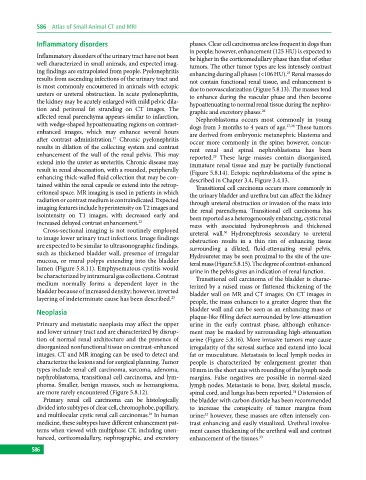Page 596 - Atlas of Small Animal CT and MRI
P. 596
586 Atlas of Small Animal CT and MRI
Inflammatory disorders phases. Clear cell carcinomas are less frequent in dogs than
in people; however, enhancement (125 HU) is expected to
Inflammatory disorders of the urinary tract have not been be higher in the corticomedullary phase than that of other
well characterized in small animals, and expected imag- tumors. The other tumor types are less intensely contrast
ing findings are extrapolated from people. Pyelonephritis enhancing during all phases (<106 HU). Renal masses do
25
results from ascending infections of the urinary tract and not contain functional renal tissue, and enhancement is
is most commonly encountered in animals with ectopic due to neovascularization (Figure 5.8.13). The masses tend
ureters or ureteral obstruction. In acute pyelonephritis, to enhance during the vascular phase and then become
the kidney may be acutely enlarged with mild pelvic dila- hypoattenuating to normal renal tissue during the nephro-
tion and perirenal fat stranding on CT images. The graphic and excretory phases. 26
affected renal parenchyma appears similar to infarction, Nephroblastoma occurs most commonly in young
with wedge‐shaped hypoattenuating regions on contrast‐ dogs from 3 months to 4 years of age. 27,28 These tumors
enhanced images, which may enhance several hours are derived from embryonic metanephric blastema and
21
after contrast administration. Chronic pyelonephritis occur more commonly in the spine; however, concur-
results in dilation of the collecting system and contrast rent renal and spinal nephroblastoma has been
enhancement of the wall of the renal pelvis. This may reported. These large masses contain disorganized,
29
extend into the ureter as ureteritis. Chronic disease may immature renal tissue and may be partially functional
result in renal abscessation, with a rounded, peripherally (Figure 5.8.14). Ectopic nephroblastoma of the spine is
enhancing thick‐walled fluid collection that may be con- described in Chapter 3.4, Figure 3.4.13.
tained within the renal capsule or extend into the retrop- Transitional cell carcinoma occurs more commonly in
eritoneal space. MR imaging is used in patients in which the urinary bladder and urethra but can affect the kidney
radiation or contrast medium is contraindicated. Expected through ureteral obstruction or invasion of the mass into
imaging features include hyperintensity on T2 images and the renal parenchyma. Transitional cell carcinoma has
isointensity on T1 images, with decreased early and been reported as a heterogeneously enhancing, cystic renal
increased delayed contrast enhancement. 22 mass with associated hydronephrosis and thickened
Cross‐sectional imaging is not routinely employed ureteral wall. Hydronephrosis secondary to ureteral
30
to image lower urinary tract infections. Image findings obstruction results in a thin rim of enhancing tissue
are expected to be similar to ultrasonographic findings, surrounding a dilated, fluid‐attenuating renal pelvis.
such as thickened bladder wall, presence of irregular Hydroureter may be seen proximal to the site of the ure-
mucosa, or mural polyps extending into the bladder teral mass (Figure 5.8.15). The degree of contrast‐enhanced
lumen (Figure 5.8.11). Emphysematous cystitis would urine in the pelvis gives an indication of renal function.
be characterized by intramural gas collections. Contrast Transitional cell carcinoma of the bladder is charac-
medium normally forms a dependent layer in the terized by a raised mass or flattened thickening of the
bladder because of increased density; however, inverted bladder wall on MR and CT images. On CT images in
layering of indeterminate cause has been described. 23 people, the mass enhances to a greater degree than the
Neoplasia bladder wall and can be seen as an enhancing mass or
plaque‐like filling defect surrounded by low‐attenuation
Primary and metastatic neoplasia may affect the upper urine in the early contrast phase, although enhance-
and lower urinary tract and are characterized by disrup- ment may be masked by surrounding high‐attenuation
tion of normal renal architecture and the presence of urine (Figure 5.8.16). More invasive tumors may cause
disorganized nonfunctional tissue on contrast‐enhanced irregularity of the serosal surface and extend into local
images. CT and MR imaging can be used to detect and fat or musculature. Metastasis to local lymph nodes in
characterize the lesions and for surgical planning. Tumor people is characterized by enlargement greater than
types include renal cell carcinoma, sarcoma, adenoma, 10 mm in the short axis with rounding of the lymph node
nephroblastoma, transitional cell carcinoma, and lym- margins. False negatives are possible in normal‐sized
phoma. Smaller, benign masses, such as hemangioma, lymph nodes. Metastasis to bone, liver, skeletal muscle,
are more rarely encountered (Figure 5.8.12). spinal cord, and lungs has been reported. Distension of
31
Primary renal cell carcinoma can be histologically the bladder with carbon dioxide has been recommended
divided into subtypes of clear cell, chromophobe, papillary, to increase the conspicuity of tumor margins from
and multilocular cystic renal call carcinomas. In human urine; however, these masses are often intensely con-
32
24
medicine, these subtypes have different enhancement pat- trast enhancing and easily visualized. Urethral involve-
terns when viewed with multiphase CT, including unen- ment causes thickening of the urethral wall and contrast
hanced, corticomedullary, nephrographic, and excretory enhancement of the tissues. 33
586

